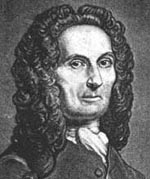Tales of Statisticians
Abraham de Moivre
26 May 1667 - 27 Nov 1754De Moivre was born in France, but went to England to escape the persecutions to which French Protestants were then subject. He thus took his place at the northwest corner of the deeply interconnected world in which the science of statistics was emerging, one insight at a time. He supported himself by teaching, but most famously as the resident statistician of Slaughter's Coffee House in London, where the gamblers would pay him to calculate odds for them. Like his friend Isaac Newton, he studied the normal distribution curve, and saw that the normal curve was the limit to which the binomial curve approaches. He defined the mean and standard deviation for the binomial curve as np and r(npq), respectively. This result is now known to posterity as the de Moivre-Laplace Theorem.

Some of his discoveries in this area were later credited to Gauss, by a process known in statistics as Stigler's Law of Eponymy, and in philology as the Rule of the Lesser Attribution. His major publication was The Doctrine of Chance, which existed in draft by 1711, and was published in 1718, with a second edition in 1738. The latter also included his limit theorem, which had had its separate first publication in a Latin pamphlet of 1733.
Vague as the history of 18th century statistics must probably remain, and with all due respect to such important figures as Huyghens and Montmort, one has the impression that statistics as a subject, a matter of consecutive interest in its own right, began to exist with the publications of de Moivre and Jacob Bernoulli, whose Ars Conjectandi was posthumously published in 1713. These treatises are the Two Towers of Statistics, and between them, the road along which the science was to develop begins for the first time to run plainly: visible as such.
Paris was the center of the intellectual world at this time, but in many ways it was not a fruitful one. De Moivre and Bernoulli were both refugees from it. Statistics as a science came of age on the fringes of that harsh but indubitable point of origin.
Statistics is Copyright © 2001- by E Bruce Brooks
4 Sept 2004 / Contact The Project / Exit to Statistics Page